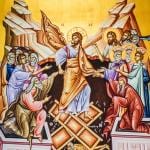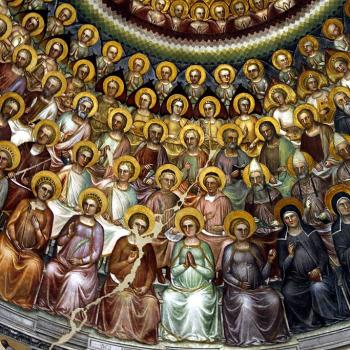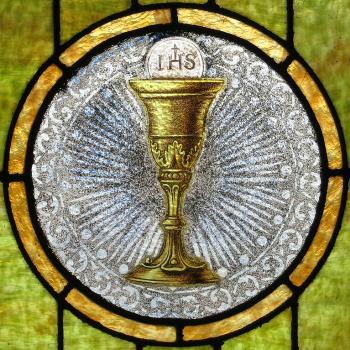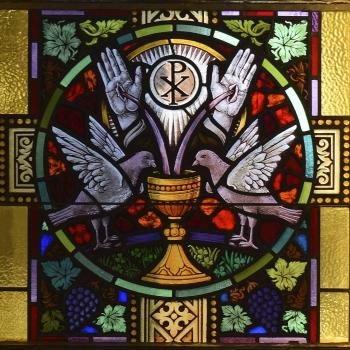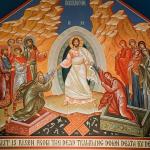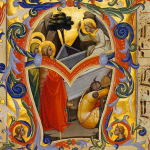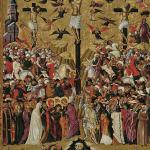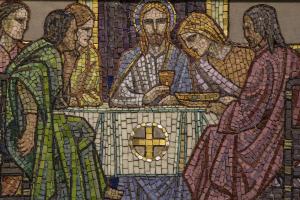
Many of us in modern society have lost our ability to appreciate or think in poetic diction. We are too literal minded. We have difficulty understanding similes and metaphors, thinking they confuse things and make interpretations based upon them as being convoluted.
Symbols have the power to use external realities and forms to represent and point to hidden realities and truths beyond appearances. Likewise, not only do they point to such realities, but they can also contain such realities in themselves. They become vessels of such realities so that they actually are what they symbolize. This is what we find with the sacraments. But because we generally do not often think and ponder the meaning of symbols, we often lose sight of the symbolism being used by the sacraments; we are more concerned with what the sacraments do for us and who and what gives the sacraments those grace than we are in figuring out how and why the sacraments come in the forms they do, as Jean Daniélou lamented: “We study the efficacious causality of the sacraments, but we pay very little attention to their nature as signs.” [1]
Our inability to appreciate and understand the symbolic element of the sacraments has led to many unnecessary theological and doctrinal conflicts. Take, for example, the eucharist. We have many faithful Christians who think Christ becomes localized in the physical accidents of the communion bread and wine. They treat the physical accidents in such a way as they confuse the substantial element of the sacrament with its physical manifestation. This confusion had led many people to reject the real presence of Christ in communion; since the physical form is not that of flesh and blood but bread and wine, they think what they partake must be bread and wine. Others, however, think what they have before them is physically flesh and blood, coming, as it were, under the illusion of bread and wine. When poetic diction is no longer understood, all that is left is this misunderstanding, this attempt to confuse the physical form with the substance of the eucharist itself. Nonetheless, those who are mistaken and believe it is physically flesh and blood are not far off, because they are right in saying it is Christ. What they need to appreciate is that the physical form is symbolic. The forms of bread and wine are used in order to show to us we are receiving spiritual food and drink. The presence of Christ is not a simple physical presence, it is a sacramental presence which employs physical forms and symbols in order to bring the reality of Christ’s presence to us (symbols which, of course, represent the truth contained in themselves and not apart from themselves, so that the eucharist truly is Christ, even if physically, what we see and experience is bread and wine).
Thus, many Christians are confused about communion. They treat the physical bread and wine as actual physical locations for Jesus. They believe what is done to the physical accidents can harm Christ. This is why they often look at in horror at the various ways people tend to abuse the eucharist. While one should not abuse the eucharist, for such an evil intent harms the one with such an intent, we must not fear that Christ will ever be harmed by what happens to the physical accidents of the bread and wine. Likewise, when the eucharist is given to the faithful, we must not think of the dividing up of the eucharist is dividing Christ up into parts; Christ is not limited, and the grace which Christ gives up is not limited. “For we do not claim that the Body of Christ is cut to pieces and thus divided is eaten by believers under the Sacrament, so that at some point the supply must fail, even if it have the magnitude of a mountain, as they say.”[2] When the physical bread and wine is divided up and received by the faithful, no matter what the physical attributes are, the reality is the same, so that it is the whole Christ which is received and experienced each time someone partakes of communion, The physical form is a symbol representing the greater reality of Christ, the Bread of Life, which we fully receive when we receive communion. When we partake of the eucharist, we find ourselves in communion with and joined in with Christ and everyone else who makes up the body of Christ. This is exactly what communion is about: rendering us the body of Christ through the reception of Christ himself into us, so that, Bulgakov stated: “Thus, originally, in the apostolic age, the Divine Eucharist as the basis of all the sacraments was exclusively that which it is as the realization of the body of the Church as the body of Christ. Its essential character was not hierarchical but koinonic” [3]
Thus, even as we must accept the truths learned through empirical sciences, we must also accept and embrace a symbolic and poetic understanding of the world. When we truly understand the value of symbols, and how they work, we will be better able to appreciate the real presence of Christ in the eucharist. We will them be able to think about Christ in ways which did not limit him to the physical attributes of the eucharistic accidents. St. Albert the Great, therefore, said that the presence must not be thought as if it existed in a physical place, but rather, we must understand through the physical sign we receive the presence of Christ, a truth indicated by the sign we understand the symbolism properly: “To the objection concerning the Lord’s body in the sacrament, we say that Christ’s body does not exist in the sacrament as in a place, but as in a sign containing within itself the truth and essence of the thing signified.” [4] When we understand that the Lord’s presence in this manner, we can then understand how and why what happens to the physical form of the sacrament cannot harm Christ himself, for Christ is not to be treated as imprisoned and trapped in the place in which we find the eucharistic bread and wine. And then we can also understand how and why there are many forms of presence by which we experience Christ, which Bede expressed:
By the frequent occurrence of his bodily manifestations our Lord wished to show, as I have said, that he is present by his divinity in every place to the desires of those who are good. He appeared at the tomb to those who were grieving; he will also be present to us when we are salutary saddened at recalling his absence. He came to meet those who were returning from the tomb so that, heaving learned of the joy of his resurrection, they might proclaim it; he will also be present to us when we rejoice in faithfully announcing the good things that we know to our neighbors. He appeared in the breaking of the bread to those who, supposing that he was a stranger, invited him to share their table; he will also be present to us when we willingly bestow whatever goods we can on strangers and poor people; and he will be present to us in the breaking of bread, when we partake with a chaste and simple conscience of the sacrament of his body, namely, the living bread.[5]
The eucharist is truly the body and blood of Christ. The presence is real. However, we must think of it in a way beyond the materialistic, apoetic, engagement with the world which is commonly held today if we are to appreciate this truth. We must truly begin to pursue poetic diction and the way it treats symbols. Then we will be able to properly engage communion for the sacrament, the mystery, which it truly is. We must get beyond an overly physical understanding of communion while not denying that in and through its physical form, the accidents, we receive an essence which transcends those symbols, and that essence is truly the essence of the sacrament itself. That way we will not end up misconstruing the physical accidents, and what happens to them, as something essential, leading to all kinds of misunderstanding, debates, and conflicts which need not ever arise.
[1] Jean Daniélou, SJ, The Bible and the Liturgy (Notre Dame, Indiana: University of Notre Dame Press, 1966), 3.
[2] St. Thomas Aquinas, On Reasons for Our Faith Against the Muslims, Greeks, and Armenians. Trans. Peter Damian Fehlner (New Bedford, MA: Franciscans of the Immaculate, 2002), 54.
[3] Sergius Bulgakov, Bride of the Lamb. Trans. Boris Jakim (Grand Rapids, MI: William B. Eerdmans Publishing Company, 2002), 287.
[4] St. Albert the Great, On Resurrection. Trans. Irven M. Resnick and Franklin T. Harkins (Washington, DC: CUA Press, 2020), 126.
[5] Bede the Venerable, Homilies on the Gospels. Book Two: Lent to the Dedication of the Church. Trans Lawrence T. Martin and David Hurst OSB (Kalamazoo, MI: Cistercian Publications, 1991), 75 [Hom. II. 8].
Stay in touch! Like A Little Bit of Nothing on Facebook.
If you liked what you read, please consider sharing it with your friends and family!


